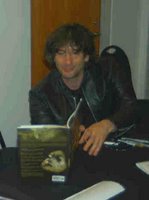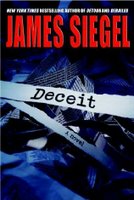 An Interview With Myth Master Neil Gaiman
An Interview With Myth Master Neil Gaiman
Interviewed by Byron MerrittIn June of this year my grandfather,
Frank Herbert, was inducted into the
Science Fiction Hall of Fame in Seattle, Washington. Neil Gaiman was the Master of Ceremonies and I’d been trying to interview him for some time, but our busy schedules always seemed at odds with each other. Since we were both going to be in the same place on the same day for the same reason, it seemed logical we might get together and chat a bit. Luckily, with the help of the staff at the SF Hall of Fame, we were able to tuck ourselves into “the green room” and talk about Frank Herbert, science fiction, and Neil’s writings.
I’d never met Neil before and I was surprised at how interesting he looked. At first sight he brought to mind the image of a rock star who’d just stepped off a Harley Davidson. A thick swath of black hair dangles into his eyes and constantly gets pushed out of his face, and his angular features are hawkish yet handsome. This was brought to my attention later by my great aunt (Frank Herbert’s sister) who whispered to me, “He
is handsome. He looks like a young Neil Diamond.”
Rock star comparisons aside, Neil Gaiman has the writing ability of the greats of our time. His Sandman Chronicles helped launch DC Comics into mainstream literature, and his multiple award wins for his fantasy and science fiction stories are proof positive that he’s no one-hit-wonder.
(Special thanks to Anne Murphy and Brooks Peck for arranging the interview)Byron Merritt: We’re kind of coming full circle here at the Science Fiction Museum and Hall of Fame in that I understand you’d interviewed my grandfather some years ago and now here we are inducting him into the SF Hall of Fame and I’m here interviewing you. What I’m dying to know is in what context did you interview Frank Herbert and what did you discuss?
Neil Gaiman: It was in 1984 or 1985 and he was in London promoting the David Lynch
Dune film. The way I remember it is that the film hadn’t come out yet. I’d done a small interview with him but the most fun I had with him was during a press conference. It was memorable because it was so wonderful and odd watching him giving a press conference to these English hack journalists. I’m not even sure if these guys still exist because we’re talking more than 20 years ago and I think they’ve probably died off. There were these guys in grubby mackintoshes with their little thumb notebooks who turn up to ask ridiculous questions. I remember going up to one of these guys and he asked me who I was covering the press conference for and I said Space Voyager Magazine or something like that. And I asked this grubby fellow what he planned on asking Mr. Herbert and he said, “I plan on asking him if he believes in little green men.” And I thought: “What the hell are you talking about? This is Frank Herbert here! Have you even read any of his books?” So the press conference goes very well. Your grandfather talks about the origins of
Dune and his writing career and the
Dune film translation; some really interesting stuff. And then at the end there’s the question and answer session and this guy in the grub

by mackintosh stands up says, “Mr. Herbert I feel as a representative of the English press I have to ask you, do you believe in unidentified flying objects.” And your grandfather says, “That’s a really good question. I absolutely believe — listen to my words very carefully — that there are ‘unidentified flying objects’ in that there are objects in the sky that people have seen that have not been identified. But I’m afraid that’s as far as I go.” “Right,” says the grubby reporter, “so when the little green men come down from their saucers do you think they’re going to take us all away?”
Byron Merritt: Oh God.
Read the rest of the interview here.
 Tom Valle is a liar. Disgraced by making up stories for a large newspaper, he is kicked out of his job only to land a new one in the nowhere community of Littleton, California. Trying to hide from his past, Tom now writes about the opening or closing of a new diner in the one-horse-town, or posts topics about equally mundane items.
Tom Valle is a liar. Disgraced by making up stories for a large newspaper, he is kicked out of his job only to land a new one in the nowhere community of Littleton, California. Trying to hide from his past, Tom now writes about the opening or closing of a new diner in the one-horse-town, or posts topics about equally mundane items.





